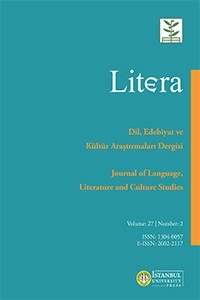Linguistic Typology in Motion Events: Expression of Motion Events in Translated Versions of Turkish and English Novels
Linguistic Typology in Motion Events: Expression of Motion Events in Translated Versions of Turkish and English Novels
___
- Aksu-Koç, A. A. (1994). Development of linguistic forms: Turkish. In R. A. Berman & D. I. Slobin (Eds.), Relating Events in Narrative: A Cross Linguistic Developmental Study (pp. 329-388). Hillsdale, NJ: Lawrence Erlbaum Associates. google scholar
- Bassnett, S. (2002). Translation Studies. London: Routledge google scholar
- Berthele R. (2004) The typology of motion and posture verbs: A variationist account. In Kortmann B. (Eds.), Dialectology Meets Typology Dialect Grammar From a Cross-Linguistic Perspective (pp. 93-126). De Gruyter, Berlin, New York. google scholar
- Bohnemeyer, J., Enfield, N. J., Essegbey, J., Ibarretxe-Antunano, I., Kita, S., Lüpke, F., & Ameka, F. K. (2007). Principles of event segmentation in language: The case of motion events. Language, 495-532. google scholar
- Demirtaş, A. D. (2009). Motion event descriptions in English by Turkish EFL Instructors [M.A. Thesis]. Anadolu University, Eskişehir. google scholar
- Ferez, P. C. & Gentner, D. (2006). Naming motion events in Spanish and English. Cognitive Linguistics, 443-462. google scholar
- Goddard, C. (1998). Semantic Analysis: A Practical Introduction. New York: Oxford University Press. google scholar
- Ibarretxe-Antunano, I. (2012). Linguistic typology in motion events: Path and manner. Anuario del Seminario de Filologia Vasca ‘Julio de Urquijo’ International Journal of Basque Linguistics and Philology, 1-39. google scholar
- Özçalijkan, $., & Slobin, D. I. (2000). Climb up vs. ascend climbing: Lexicalization choices in expressing motion events with manner and path components. In Proceedings of the 24th Annual Boston University Conference on Language Development (Vol. 2, pp. 558-570). Somerville, MA, Cascadilla Press. google scholar
- Özçalijkan, $. (2003). In a caravanserai with two doors I am walking day and night: Metaphors of death and life in Turkish. Cognitive linguistics, 281-320. google scholar
- Özçalijkan, $. & Slobin, D.I. (2003). Codability effects on the expression of manner of motion in English and Turkish. In A.S. Özsoy, D. Akar, M. Nakipoglu-Demiralp, E.E. Taylan & A. Aksu-Ko^ (Eds.), Studies in Turkish Linguistics (pp. 259-270). Istanbul: Bogaziq University Press. google scholar
- Özçalijkan, $. (2004). Typological variation in encoding the manner, path, and ground components of a metaphorical motion event. Annual Review of Cognitive Linguistics, 2(1), 73-102. google scholar
- Slobin, D. I. (1996a). From “thought and language” to “thinking for speaking”. Rethinking Linguistic Relativity, 17, 70-96. google scholar
- Slobin, D. I. (1996b). Two ways to travel: Verbs of motion in English and Spanish. Grammatical Constructions: Their form and meaning, 195-219. google scholar
- Slobin, D.I. (1997). Mind, code, and text. In J. Bybee, J. Haiman, & S.A. Thompson (Eds.), Essays on Language Function and Language Type: Dedicated to T. Givon (pp. 437-467). Philadelphia: John Benjamins. google scholar
- Slobin, D. I. (2000). Verbalized events: A dynamic approach to linguistic relativity and determinism. Evidence for Linguistic Relativity, 107-138. google scholar
- Slobin, D. I. (2003). Language and thought online: Cognitive consequences of linguistic relativity. In D. Gentner, S. Goldin-Meadow (Eds.), Language in Mind: Advances in the Investigation of Language and Thought (pp. 157191). MIT Press, Cambridge, MA. google scholar
- Slobin, D. I. (2004). The many ways to search for a frog. Relating events in narrative. Typological and Contextual Perspectives, 219-257. google scholar
- Slobin, D. I. (2005). Linguistic representations of motion events: What is signifier and what is signified. Iconicity Inside Out: Iconicity in Language and Literature, 4, 307-322. google scholar
- Talmy, L. (1985). Lexicalization patterns: Semantic structure in lexical forms. In Shopen, T. (Eds.), Language Typology and Syntactic Description, Vol. 3: Grammatical Categories and the Lexicon (pp. 57-149). Cambridge: Cambridge University Press. google scholar
- Talmy, L. (1991). Path to realization: A typology of event conflation. Proceedings of the Berkeley Linguistics Society, 17, 480-519. google scholar
- Talmy, L. (2000). Toward a Cognitive Semantics Volume II: Typology and Process in Concept Structuring. Cambridge, MA: MIT Press. google scholar
- Başlangıç: 1954
- Yayıncı: İstanbul Üniversitesi
Peter Shaffer’s Equus and Equine-assisted Psychotherapy (EAP)
Kazuo Ishiguro’s The Unconsoled:An Interdisciplinary Analysis
A Criticism of the British Left in Trevor Griffiths’s The Party in Light of ’68 Paris Student Riots
Analysis of the Mythical Discourse of “La esfinge de oro” by Carlos Raúl Sepúlveda
Kurgusal Eserlerde Otizm Ve Buzdolabı Anne Teorisi: Pauline Holdstock’ın Here I Am! Adlı Romanı
Homines Sacri of Eskibahçe: An Agambenian Reading of Louis de Bernières’ Birds without Wings
Çeviri Eğitiminde Kavram Haritalarının Kullanımı
Whatever Singularity in de Bernières’ Captain Corelli’s Mandolin
The Landscape of Middle English Focusing on the Adverb Even
Commensality and Togetherness in Becky Chambers’ The Long Way to a Small, Angry Planet
